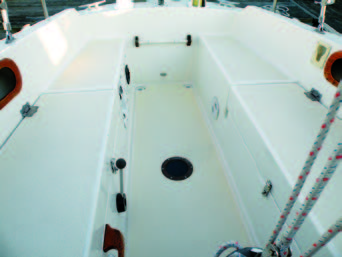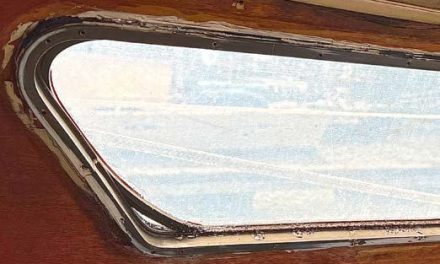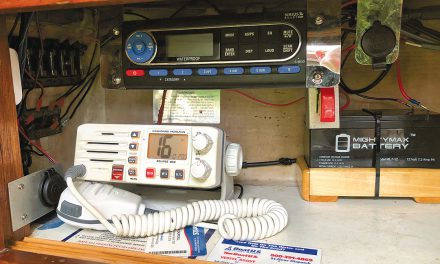
Banish mildew on your boat with a simple chemical brew
As near as I can tell, boating consists of one part blue lagoons and white sails and two parts painting the bottom, fixing engines, and scrubbing mildew. While I can’t change the overall reality, I don’t scrub mildew anymore. How about them apples?
More than a decade ago, while researching borate-based wood preservatives, I took a slight detour into mildew cleaners and preventatives. Our then new-to-us house was a good value in a very popular neighborhood. The backyard was heavily wooded, with 100-year-old oaks and mountain laurel . . . and the basement had a nasty habit of flooding every few years, bringing with it mud and mildew. At the time of one particularly bad flood, I had a severe flare-up of back spasms, which confined me to bed. I was unable to tackle cleaning the carpets for nearly two weeks and by that time the carpet was a smelly multi-colored science project. But as a 30-year chemical engineer (at the time), I dug into what I knew about microbes and cleaning chemistry, and came up with what turned out to be a novel and brutally effective weapon against the scourge of boat stink and black spots.
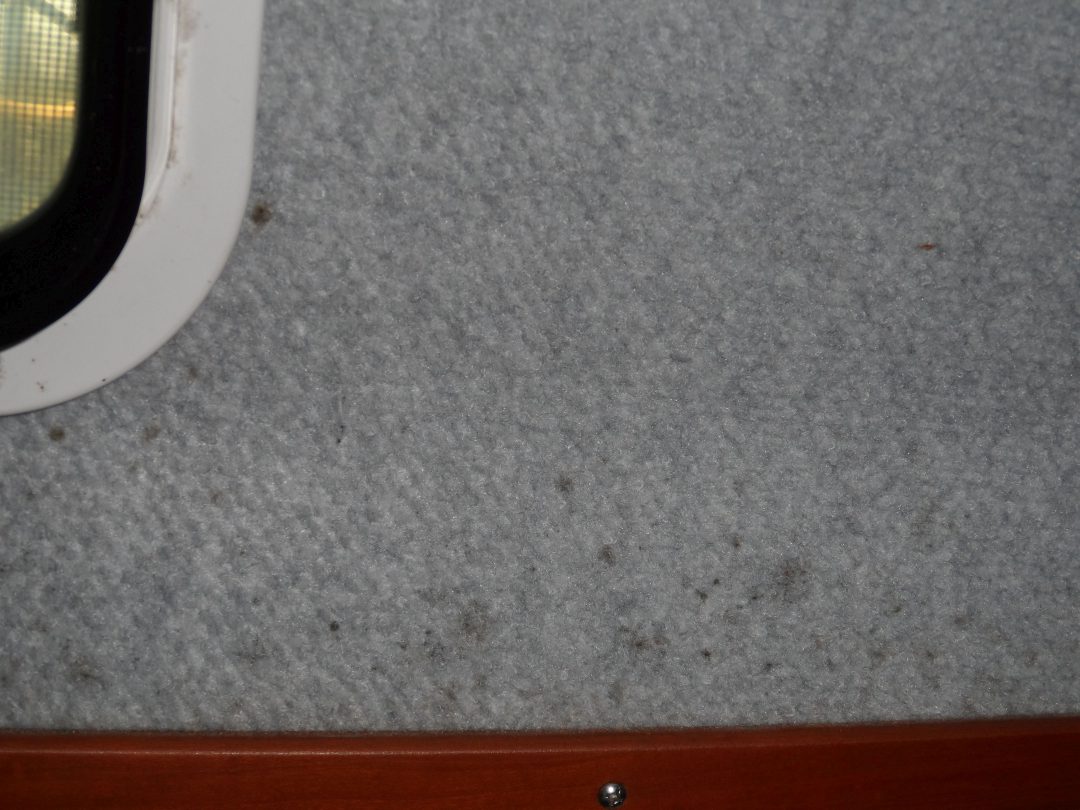
Before treatment, this area of carpeting was covered with black mildew spots.
Mildew requires specific factors to flourish. Dark is nice, but it need not be total, just screened of strong ultra-violet light (UV). Free water or accessible absorbed water is required, but it doesn’t need to be continuous, as it easily survives the dry times in a dormant state. Mildew needs something to eat, but it doesn’t take much. Synthetic fabrics don’t provide food, but soils do, and ironically, so do the residues of many cleaners and soaps, most of which are based on fatty acids or organic chemicals that mildew finds delicious. A surface pH in a livable range (neutral to slightly acidic) is vital. On deck, we can find mildew in shady corners and under lines. In the cabin, it invades our bedding, lockers, and perhaps most annoyingly, carpet head and hull liners.

Armed with a spray bottle of Formula B, a scrub brush, and an upholstery vacuum extractor, Drew attacked the mildewed carpet hull liner. That area remained mildew-free after 80 months. Six months after treatment, it was still free of mildew.
The first step in mildew prevention is to keep the boat dry
Moisture is a key requirement for mildew growth, so the first line of defense is to keep the boat dry. That’s a challenge, but boats respond well to a systematic approach.
Leaks
Most of my boating mildew experience comes from minor hatch leaks. The carpet liner gets just a few drops now and then — not enough to be noticed, but enough to irrigate the crop. One new-to-me boat suffered from multiple deck leaks. I rebedded the deck hardware and was confident I knew just the chemistry to set right the interior, which looked like a Jackson Pollock painting.
Bilge
Can you keep the bilge dry? Failing that, can you vent the inevitable moisture to the outside instead of up through the cabin? In winter, it is generally sufficient to simply seal off the bilge. Nothing can grow in the cold, and there is practically no water vapor in the air at near-freezing temperatures.
Ventilation
Some people swear that more ventilation solves everything. Why then, on a freakishly warm and sunny mid-winter’s day, are the sidewalks and streets soaking wet, as though it rained overnight? The answer is condensation. The ground is still frozen and the air is 60 degrees and loaded with water. In stable weather conditions, a good flow of air is proof against condensation, but a boat that’s kept in the water or gets snow on the deck is going to collect some damp.
Dehumidify
If all else fails, run a small dehumidifier. Over the past 10 years, we’ve been happy with the Peltier-effect (aka thermoelectric- effect) type of dehumidifier. Because it uses a thermopile instead of a compressor, the only moving part is a fan, as opposed to compressor-driven dehumidifiers, which are regulated to turn off below about 55°F to prevent icing. All that is required is a defrost cycle, easily provided by using a timer or day/night lamp controller. It can safely operate at sub-freezing temperatures, and freezing solid will not harm it. A dehumidifier is most efficient at night, when humidity is highest. The greenhouse effect often warms the cabin above freezing during the day.
Peltier-effect dehumidifiers are quiet, typically rated at only a few quarts per day, and use very little power, reducing the risk of fire. They are even available in 12-volt models. My favorite is the Eva-Dry 2200, but I have used others. They won’t pump out all the moisture a liveaboard can generate, but they will keep a sealed boat bone-dry — you don’t ventilate and dehumidify at the same time, only one or the other. You will need to add a small drain hose to the tank (3?16 inch is enough) and find a place to lead it. A sink is good if the drain is above the waterline.
But . . . if you own or buy a used boat, it will come with a history of mildew, and damp will always sneak in when you aren’t looking.
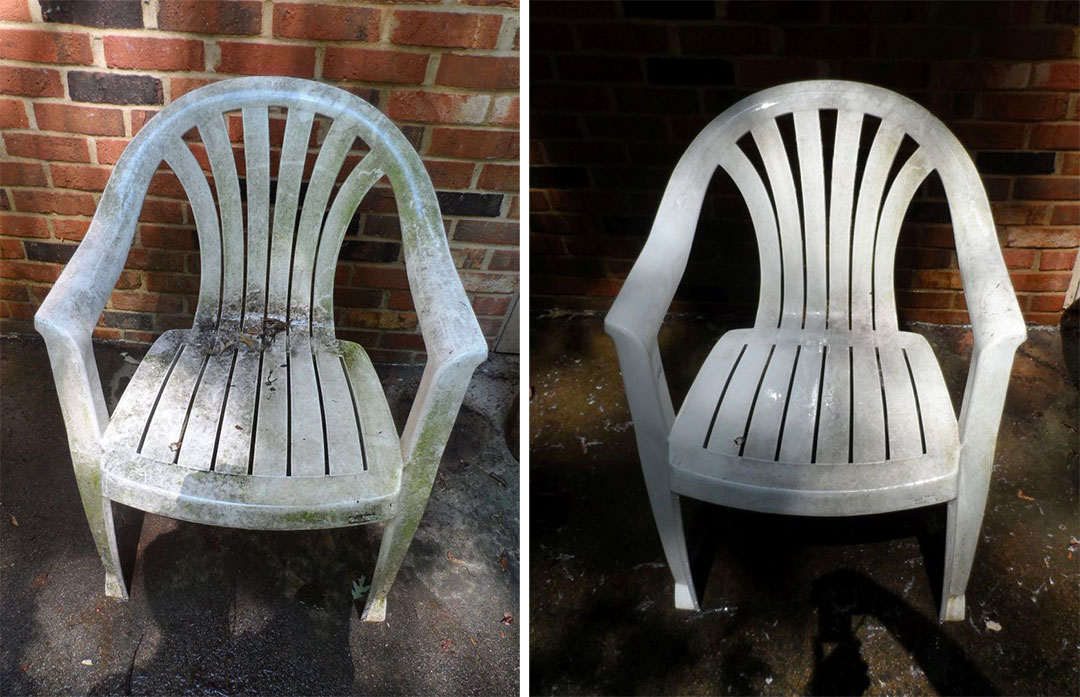
In the before photo (left), the side of the chair to the viewer’s right has been scrubbed with water only. In the after photo (right), the mildewed chair has been scrubbed from the center toward the viewer’s left with Formula B, and the left arm and leg with a bleach-based cleaner. The bleach does a better job of cleaning, but should only be used on color-fast surfaces.
Anti-mildew chemistry at work
Formula B, my mildew-busting brew (see “Formula B Mold Remover,” below), has many uses onboard a boat and around the house. Its work-horse application for me is cleaning synthetic carpets of mildew and soil.
Carpeting
Apply the mildew fighting solution with either a trigger spray for small jobs or a pump-up garden sprayer for larger jobs. Wet the carpet thoroughly, but not to the point that it’s dripping, and work only the area you can finish within a 20-minute period. Allow it to soak for 5 to10 minutes, scrub the carpet lightly (or more firmly if needed) with a bristle brush, then vacuum up the residue with a carpet extractor or shop vac, pulling out as much of the dirty solution as possible. Because the dirt and dead mildew are removed only by extracting the spent solution, use plenty and expect to do all stained areas twice. Lightly spray clean areas as a preventative, and suck up any excess solution. The residue kills any smell and prevents the return of mildew.
Hard surfaces
Use the same soak time as for carpeted surfaces, and remove the spent mildew removal solution with a wrung-out cloth. Wipe it off with a cloth rinsed in tap water, then give the surfaces a final wipe with a cloth lightly dampened with the solution.
Teak decks
The best treatment for mildew is a regular scrubbing across the grain with seawater. Most commercial teak cleaners are very aggressive formulations based on oxalic acid and typically remove about 0.01 inch of your deck every time they are used for “restoring” the deck — these are not chemicals you want to use regularly or even every year. However, Formula B will kill mildew and clean the deck without damage, while imparting some resistance to recurrence in the process — perfect for a non-damaging spring cleanup.
Sails
Borax formulations are good for cleaning sails (especially when followed with OxyClean) but are not the first choice for mildew prevention. First, keep them dry, but if that is impossible, a light spraying with benzalkonium chloride (BAC), a common antiseptic, seems to be a bit more durable, particularly in the rain. The cheapest source is swimming-pool algae treatment, and a favorite brand is HTH Algae Guard 3X Concentrate. Mix 1 ounce per gallon of cold water, or about ½ cup in the typical 3- to 4-gallon garden sprayer.
Rope and canvas
These respond better when waterproofing treatments are used to keep them dry. Ropes treated with Nikwax Polar Proof will be freeze-proof, handle better, squeak less, gain less weight, and stay mildew-free. The treatment does not weaken the rope — ice climbers use it to prevent frozen ropes. (I am not aware of any other water-repellent treatments that have been tested on climbing ropes.) Canvas should be cleaned and then waterproofed; canvas that dries quickly doesn’t grow algae or lichen.
Bedding and clothing
Borax can be irritating to the skin, so avoid using Formula B on clothing or bedding without a very thorough rinsing, following normal laundry instructions. However, used correctly, it can be an effective way to kill mildew. This formulation is safe for use on upholstery.
Pet mess
The antibacterial properties of Formula B will prevent the return of odor. If the mess has been there a few days, sometimes adding about 1/8-cup Renuzit Super Odor Neutralizer or something equivalent helps; cleaning miracles go only so far.
Formula B has many uses around the home. It’s ideal for cleaning basement carpets, of course, and works well on decks and siding.
Used on mildewed drywall before it has been primed, it’s very effective at killing the mildew and preventing its return. It will not interfere with paint adhesion (many cleaners do).
In automobiles, it cleans seats and carpets and keeps them from getting musty in damp weather. However, for the shade-tree mechanic, it is not a degreaser.
Borax Formula Comparison Tests
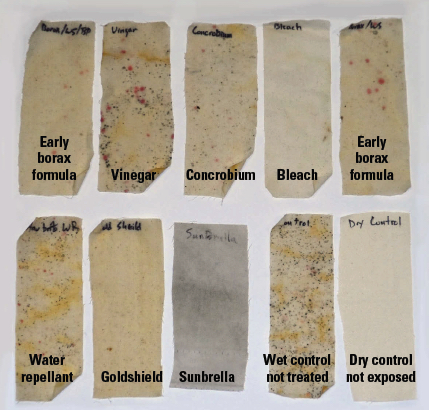
Drew tested his formula against other products by exposing treated canvas strips in a box of wet leaves for three months. Early borax products showed promise in the first round of testing.

In a later test, the final formulation outperformed all others, including bleach, in preventing the return of mildew.
Alternatives to Formula B
Concrobium, based on washing soda, baking soda, and TSP, is highly regarded and did well in side-by-side testing. It consistently finished second, behind the borax formulation, but at $22 per gallon.
I’ve probably used 50 gallons or more of this formulation over the last 10 years, much of it on basement carpets, but quite a few gallons on carpeted cabin liners and inside lockers. I’ve shared it with many people and received nothing but positive, often amazed, reviews. It’s simple chemistry, but so far, no one puts it in a bottle.
Formula B Mold Remover
Formula B is made with borax and washing soda, which can be found in the grocery store, and trisodium phosphate (TSP), which is sold in the paint departments of most hardware stores.
Ingredients
- To 1 gallon of warm water, add
- 1/4 cup borax
- 2 tablespoons TSP (not TSP substitute)
- 2 tablespoons washing soda
Shake the mixture vigorously for a few moments, then swirl it every few minutes. The powder should all dissolve in less than 5 minutes.
One of the primary features of this product is that it does not require rinsing. If formulated at this strength and the free liquid is removed by sponging or vacuuming, the residue that remains will be just sufficient to prevent the return of mildew without being noticeable.
For severe cases, the concentration may be doubled. But do NOT increase the concentration beyond this in the expectation that more is better. That will not make it more effective at cleaning.

